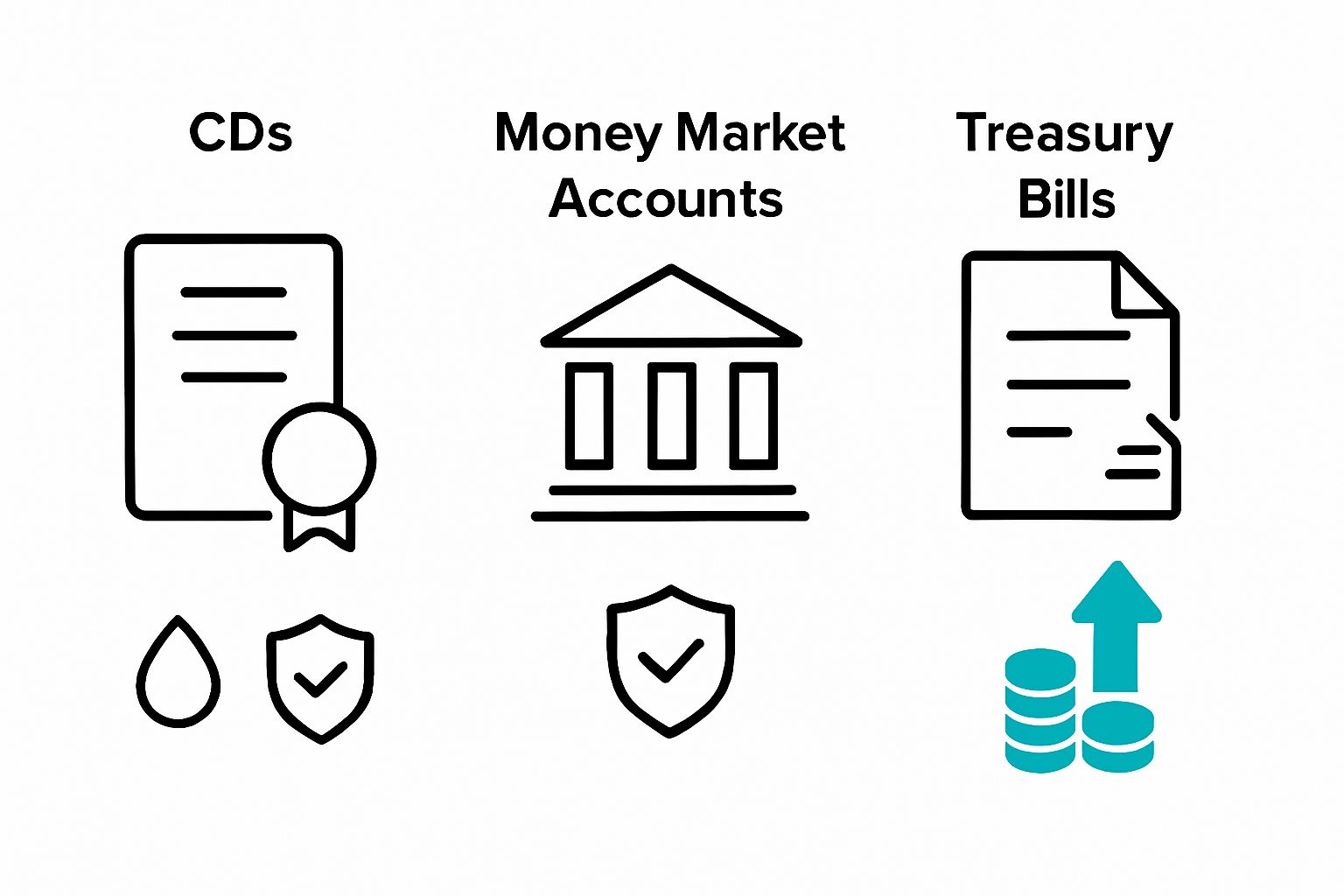Short term investment options are everywhere. People might assume these choices are just safe places to stash extra cash for a rainy day and hardly worth a second glance. But here is a surprise. These strategies are built around high liquidity and can deliver stable returns within less than a year, making them an essential part of smart financial planning for millions. The real story is not about settling for less, but about unlocking flexibility and security in uncertain times.
Table of Contents
- What Are Short Term Investment Options?
- Why Do Short Term Investments Matter?
- How Short Term Investments Work
- Key Concepts In Short Term Investing
- Real World Applications Of Short Term Investments
Quick Summary
| Takeaway | Explanation |
|---|---|
| Short term investments are for liquidity | These investments provide quick access to funds while preserving capital without exposing investors to high risks. |
| Evaluate investment options based on goals | Understanding personal financial goals and risk tolerance helps select the best short term investment vehicle. |
| Short term investments generate modest returns | While offering lower risk, these options produce predictable but generally lower returns compared to long-term investments. |
| Use short term investments for immediate needs | Ideal for saving towards planned expenses or managing financial buffers during economic uncertainties. |
| Focus on features like liquidity and fees | When choosing investments, assess their liquidity, potential returns, and associated costs for better financial decisions. |
What Are Short Term Investment Options?
Short term investment options represent financial strategies designed to generate returns within a brief timeframe, typically one year or less. Investopedia defines these investments as highly liquid assets that can be quickly converted to cash while offering modest but relatively stable returns.
Understanding Investment Duration
Investors consider short term investment options when they need capital preservation and want to earn some returns without significant market risk. These investments serve multiple purposes: parking emergency funds, saving for near-term expenses, or preparing for upcoming financial commitments.
Key characteristics of short term investment options include:
- Quick liquidity and minimal lock-in periods
- Lower risk compared to long-term investments
- Typically lower returns reflecting reduced risk exposure
- Flexibility to access funds within months
Types of Short Term Investment Strategies
Multiple investment vehicles fit the short term investment profile. Common options range from traditional bank products to more sophisticated financial instruments. Learn more about safe investment strategies on our comprehensive guide.
Some popular short term investment options include:


- Certificates of Deposit (CDs): Fixed-rate bank products with predetermined maturity dates
- Money Market Accounts: Low-risk savings accounts offering slightly higher interest rates
- Treasury Bills: Government-backed securities with minimal default risk
- High-Yield Savings Accounts: Online bank accounts providing competitive interest rates
Choosing the right short term investment requires understanding your specific financial goals, risk tolerance, and immediate cash flow needs. Investors should carefully evaluate potential returns, liquidity, and associated fees before committing their funds.
To help you quickly compare your options, here is a table highlighting the key features of common short term investment types discussed in the article.
| Investment Type | Liquidity | Risk Level | Typical Return | Accessibility |
|---|---|---|---|---|
| Certificates of Deposit (CDs) | Moderate (after maturity) | Low | Predictable, fixed | At banks, requires locking funds until maturity |
| Money Market Accounts | High | Low | Slightly higher than regular savings | At banks and credit unions |
| Treasury Bills | High | Very Low | Modest, government-backed | Purchased through government or brokers |
| High-Yield Savings Accounts | Very High | Low | Competitive variable | Online banks, easy withdrawal |
Why Do Short Term Investments Matter?
Short term investments play a critical role in personal financial management, offering strategic advantages that extend beyond simple wealth accumulation. According to the Securities and Exchange Commission, understanding these investment vehicles helps individuals maintain financial flexibility and stability.
Financial Flexibility and Risk Management
Short term investments serve multiple strategic purposes in a balanced financial portfolio. They provide crucial benefits that address immediate financial needs while protecting against unexpected economic challenges. Investors use these instruments to maintain liquidity without exposing themselves to significant market volatility.
Key strategic advantages of short term investments include:
- Protecting emergency funds from inflationary erosion
- Creating a financial buffer against unexpected expenses
- Generating modest returns on idle cash
- Maintaining capital accessibility during uncertain economic periods
Bridging Financial Goals
These investment options act as a critical bridge between current financial status and future objectives. Explore our comprehensive guide on saving versus investing to understand how short term investments fit into broader financial planning strategies.
Short term investments become particularly valuable in scenarios such as:
- Saving for major purchases within 1-2 years
- Accumulating down payment funds for real estate
- Preparing for significant life transitions
- Managing funds between long-term investment opportunities
By strategically allocating resources into short term investment vehicles, individuals can optimize their financial resources while maintaining the flexibility to adapt to changing economic landscapes. The key is selecting instruments that align with personal risk tolerance and specific financial timelines.
How Short Term Investments Work
Short term investments function through carefully structured financial mechanisms designed to balance accessibility, safety, and modest returns.
VIDEO:video_content] [The Federal Reserve explains that these investment vehicles operate on principles of liquidity and controlled risk exposure.
Investment Mechanics and Performance
Short term investments generate returns through interest earnings, yields, or minimal market appreciation within a condensed timeframe. Investors select these instruments based on specific criteria including maturity period, expected returns, and risk tolerance. The underlying principle involves parking funds in low-risk financial products that provide quick conversion to cash while generating marginally higher returns compared to standard savings accounts.
Key operational characteristics include:
- Predetermined investment duration (typically under 12 months)
- Predictable and stable return mechanisms
- Minimal exposure to significant market fluctuations
- Quick accessibility of invested capital
Risk Assessment and Return Strategies
Understanding the risk-return relationship is crucial in short term investment strategies. Investors evaluate potential instruments based on their unique financial goals and risk appetite. Learn more about comprehensive investment planning strategies to develop a holistic approach to financial growth.
Factors influencing short term investment performance encompass:
- Current interest rate environment
- Overall economic stability
- Individual financial institution’s credibility
- Specific product features and terms
The mechanics of short term investments revolve around transferring funds into financial instruments that offer controlled growth while maintaining high liquidity. Whether through bank products, government securities, or money market funds, these investments provide a strategic bridge between immediate cash needs and potential long-term wealth accumulation.
Key Concepts in Short Term Investing
Short term investing involves sophisticated financial principles that guide strategic decision making and risk management. According to the Corporate Finance Institute, understanding these fundamental concepts is crucial for effective financial planning.
Core Investment Principles
Short term investing fundamentally revolves around balancing potential returns with immediate financial accessibility. Investors must navigate complex financial landscapes by understanding key strategic elements that influence investment performance. The primary objective is preserving capital while generating modest yet reliable returns within a compressed timeframe.
Critical conceptual foundations include:
- Capital preservation as the primary investment goal
- Minimizing potential loss through calculated risk strategies
- Maintaining high liquidity for financial flexibility
- Generating predictable returns within short investment cycles
Risk and Return Dynamics
Investors must comprehensively assess the intricate relationship between risk tolerance and potential investment returns. Learn more about building a comprehensive investment portfolio to develop nuanced financial strategies.
Significant factors influencing short term investment decisions encompass:
- Interest rate fluctuations
- Economic market conditions
- Individual financial institution credibility
- Specific investment instrument characteristics
Effective short term investing requires a disciplined approach that prioritizes financial objectives, understands market complexities, and maintains a strategic perspective on wealth management. Successful investors continuously educate themselves about evolving financial mechanisms and adapt their strategies accordingly.
Real World Applications of Short Term Investments
Short term investments serve critical practical functions across various personal and professional financial scenarios. According to financial research from Bankrate, these financial tools provide strategic solutions for immediate and near-future monetary needs.
Personal Financial Planning
Individuals leverage short term investments as flexible financial instruments to address specific life objectives. These investments act as strategic buffers, helping people manage unexpected expenses, accumulate funds for significant purchases, and maintain financial stability during transitional periods.
Common personal scenarios for short term investments include:
- Saving for a home down payment within 2-3 years
- Building an emergency fund with accessible capital
- Preparing for major life events like weddings or educational expenses
- Managing funds between long-term investment opportunities
Professional and Business Applications
Businesses utilize short term investments to optimize cash management and generate modest returns on surplus funds. Explore our comprehensive guide on building investment portfolios to understand advanced financial strategies.
Key professional applications encompass:
- Maintaining operational liquidity
- Generating incremental returns on idle corporate funds
- Managing cash reserves during business growth phases
- Providing financial flexibility during economic uncertainties
Short term investments bridge the gap between immediate financial requirements and long-term wealth accumulation strategies.
This table summarizes the main purposes and applications for short term investments in both personal and business contexts, making it easy to see how they are used in real-world financial scenarios.
| Application Context | Common Uses | Example Scenarios |
|---|---|---|
| Personal Financial Planning | Building emergency funds, saving for near-term goals, managing funds between investments | Preparing for major purchases, covering life transitions |
| Professional/Business | Optimizing cash management, managing liquidity, earning returns on surplus funds | Managing reserves during growth, ensuring rapid access |


Take Control of Your Short Term Investment Strategy Today
Navigating short term investment options can feel overwhelming, especially when you need both liquidity and security for upcoming expenses or emergency funds. If you are unsure where to place your money for the best blend of safety, quick access, and competitive returns, you are not alone. Many readers share these concerns about balancing risk, liquidity, and returns in the short term without sacrificing long-term plans.
Ready to turn your savings strategy into real financial growth? Visit FinBlog now and discover expert guidance tailored to your current needs. Want to go further? Explore our trusted insights on safe investment options and find out how to build an investment portfolio that matches your timeline. Do not wait for your short term goals to slip by. Complete the quick form on finblog.com today and start moving your financial goals forward with confidence.
Frequently Asked Questions
What are short term investment options?
Short term investment options are financial strategies designed to generate returns within one year or less. They typically include highly liquid assets that can be quickly converted to cash, offering modest but relatively stable returns.
Why should I consider short term investments?
Short term investments are ideal for capital preservation and generating returns without significant market risk. They are beneficial for saving for near-term expenses, maintaining liquidity for emergencies, or managing funds between long-term investment opportunities.
What are some common types of short term investments?
Common types of short term investments include Certificates of Deposit (CDs), money market accounts, Treasury bills, and high-yield savings accounts. Each of these options offers different levels of risk and return, allowing you to choose based on your financial goals.
How do short term investments generate returns?
Short term investments typically generate returns through interest earnings, yields, or minimal market appreciation over a condensed timeframe. They provide predictable and stable return mechanisms while maintaining high liquidity, allowing easy access to invested capital.










